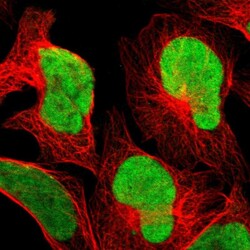Antibody data
- Antibody Data
- Antigen structure
- References [5]
- Comments [0]
- Validations
- Immunocytochemistry [1]
Submit
Validation data
Reference
Comment
Report error
- Product number
- HPA004003 - Provider product page

- Provider
- Atlas Antibodies
- Proper citation
- Atlas Antibodies Cat#HPA004003, RRID:AB_2667113
- Product name
- Anti-CXorf67
- Antibody type
- Polyclonal
- Description
- Polyclonal Antibody against Human CXorf67, Gene description: chromosome X open reading frame 67, Validated applications: ICC, WB, IHC, Uniprot ID: Q86X51, Storage: Store at +4°C for short term storage. Long time storage is recommended at -20°C.
- Reactivity
- Human
- Host
- Rabbit
- Conjugate
- Unconjugated
- Isotype
- IgG
- Vial size
- 100 µl
- Concentration
- 0.1 mg/ml
- Storage
- Store at +4°C for short term storage. Long time storage is recommended at -20°C.
- Handling
- The antibody solution should be gently mixed before use.
Submitted references Clinically relevant molecular hallmarks of PFA ependymomas display intratumoral heterogeneity and correlate with tumor morphology
Histone H3-wild type diffuse midline gliomas with H3K27me3 loss are a distinct entity with exclusive EGFR or ACVR1 mutation and differential methylation of homeobox genes
In vivo loss of tumorigenicity in a patient-derived orthotopic xenograft mouse model of ependymoma
CATACOMB: An endogenous inducible gene that antagonizes H3K27 methylation activity of Polycomb repressive complex 2 via an H3K27M-like mechanism
PFA ependymoma-associated protein EZHIP inhibits PRC2 activity through a H3 K27M-like mechanism
Gödicke S, Kresbach C, Ehlert M, Obrecht D, Altendorf L, Hack K, von Hoff K, Carén H, Melcher V, Kerl K, Englinger B, Filbin M, Pajtler K, Gojo J, Pietsch T, Rutkowski S, Schüller U
Acta Neuropathologica 2024;147(1)
Acta Neuropathologica 2024;147(1)
Histone H3-wild type diffuse midline gliomas with H3K27me3 loss are a distinct entity with exclusive EGFR or ACVR1 mutation and differential methylation of homeobox genes
Ajuyah P, Mayoh C, Lau L, Barahona P, Wong M, Chambers H, Valdes-Mora F, Senapati A, Gifford A, D’Arcy C, Hansford J, Manoharan N, Nicholls W, Williams M, Wood P, Cowley M, Tyrrell V, Haber M, Ekert P, Ziegler D, Khuong-Quang D
Scientific Reports 2023;13(1)
Scientific Reports 2023;13(1)
In vivo loss of tumorigenicity in a patient-derived orthotopic xenograft mouse model of ependymoma
Whitehouse J, Hii H, Mayoh C, Wong M, Ajuyah P, Barahona P, Cui L, Dholaria H, White C, Buntine M, Byrne J, Rodrigues da Silva K, Howlett M, Girard E, Tsoli M, Ziegler D, Dyke J, Lee S, Ekert P, Cowley M, Gottardo N, Endersby R
Frontiers in Oncology 2023;13
Frontiers in Oncology 2023;13
CATACOMB: An endogenous inducible gene that antagonizes H3K27 methylation activity of Polycomb repressive complex 2 via an H3K27M-like mechanism
Piunti A, Smith E, Morgan M, Ugarenko M, Khaltyan N, Helmin K, Ryan C, Murray D, Rickels R, Yilmaz B, Rendleman E, Savas J, Singer B, Bulun S, Shilatifard A
Science Advances 2019;5(7)
Science Advances 2019;5(7)
PFA ependymoma-associated protein EZHIP inhibits PRC2 activity through a H3 K27M-like mechanism
Jain S, Do T, Lund P, Rashoff A, Diehl K, Cieslik M, Bajic A, Juretic N, Deshmukh S, Venneti S, Muir T, Garcia B, Jabado N, Lewis P
Nature Communications 2019;10(1)
Nature Communications 2019;10(1)
No comments: Submit comment
Supportive validation
- Submitted by
- Atlas Antibodies (provider)
- Main image

- Experimental details
- Immunofluorescent staining of human cell line U-2 OS shows localization to nucleoplasm.
- Sample type
- Human
 Explore
Explore Validate
Validate Learn
Learn Western blot
Western blot Immunocytochemistry
Immunocytochemistry